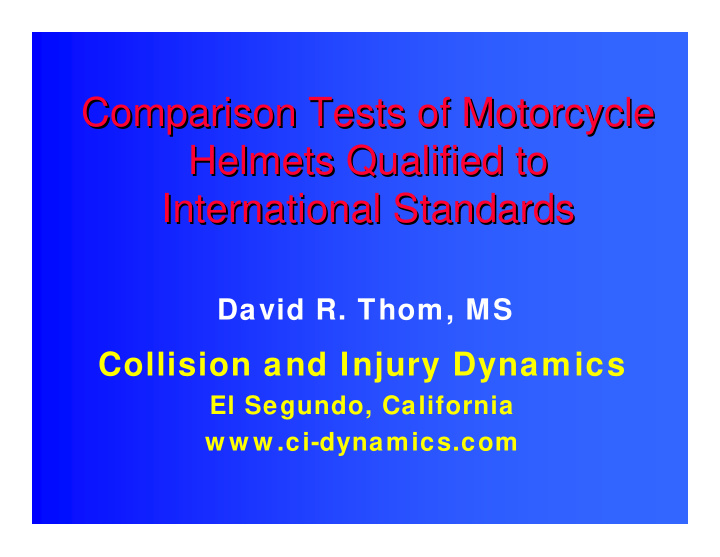



Comparison Tests of Motorcycle Comparison Tests of Motorcycle Helmets Qualified to Helmets Qualified to International Standards International Standards David R. Thom, MS Collision and Injury Dynamics El Segundo, California w w w .ci-dynamics.com
Motorcycle Helmet Standards Motorcycle Helmet Standards � FMVSS No. 218 (DOT) – Mandatory* for motorcycle use – (* but poorly enforced) � Snell Memorial Foundation � British Standards Institution 6658 � ECE 22.05 (European Commission)
2005 Real- -World Tests World Tests 2005 Real � 2 & 3 meter drop heights � Flat pavement impact surface � Aggressive metal edge impact � One impact per site
Real- -World Tests World Tests Real � Two and three meter drop heights represent 90 th and 99 th percentile impacts
Real- -World Tests World Tests Real � Flat pavement impact surface--Just like the roads we crash on. � Hurt Study found 87% of all helmet impacts to be against flat surfaces � 71% of the impacts on pavement
Real- -World Tests World Tests Real � Aggressive metal edge impact surface � Because there are 11% things out there to hit that are not flat.
Real- -World Tests World Tests Real � One impact per site--Just like real crashes � Hurt Study found 91% single critical impact � Only 6.3% had any second impact at the same site…and at far lower energy
Monorail Test Apparatus Monorail Test Apparatus ISO SIZE J HEADFORM ASPHALT PAVEMENT ANVIL
Helmet Components Helmet Components Shell EPS Liner EPS Liner Shell Fit Padding Retention System
One Part EPS Liners One Part EPS Liners
-Part EPS Liners Part EPS Liners Two- Two
-Part EPS Liners Part EPS Liners Multi- Multi
-Zone EPS Zone EPS Crush- Crush
1992 & 2005 Tests 1992 & 2005 Tests 1992 10 2005 3 Standard foot meter % change (3m) (9.8 ft) DOT 254g 182g -28.3 DOT-BSI None 207g NA Tested DOT-ECE None 191g NA Tested DOT-Snell 252g 223g -11.5
1992 & 2005 Tests 1992 & 2005 Tests 1992 10 2005 3 Standards foot meter % (3m) (9.8 ft) change DOT 254g 182g -28.3 DOT-BSI None 207g NA DOT-ECE None 191g NA DOT-Snell 252g 223g -11.5
Lower Acceleration is Better Lower Acceleration is Better � There is no “magic” line at 300g: 299g is no better than 301g � “Future improvements are more likely to come from reduced acceleration limits than from increased impact energy requirements.” (Hurt, 1993)
Lower Acceleration is Better Lower Acceleration is Better � DOT’s effective limit is 250g � European ECE 22.05 limit 275g � European COST 327 proposed standard has a limit of 180g for some impacts
Conclusion: Conclusion: helmets are better now. helmets are better now.
More Conclusions More Conclusions � Full face helmets have better impact attenuation in 2005 than in 1992 � Helmets are available in the US meeting European standards & DOT � The standards met correlates well with impact performance in realistic tests � DOT-only performs best, followed by ECE, BSI and Snell qualified helmets
More Conclusions & More Conclusions & Some Problems Some Problems � More riders are wearing: – Nothing – Partial coverage helmets – Fake helmets
Thank you for your attention ! Thank you for your attention !
Internet Resources Internet Resources � AMA – ama-cycle.org � Collision Dynamics- ci-dynamics.com � DOT-NHTSA – nhtsa.dot.gov � Dynamic Research – dynres.com � HPRL – hprl.org � Motorcyclist– motorcyclistonline.com � MSF – msf-usa.org � Snell Foundation – smf.org
Recommend
More recommend